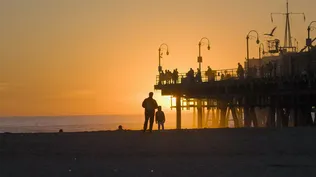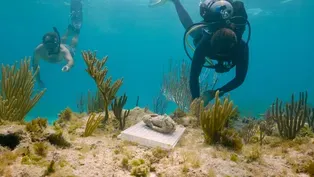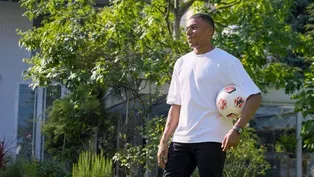
Ari Explores Various New Forms of Clean Energy
Clip: Episode 6 | 9m 44sVideo has Closed Captions
Ari visits Iceland, a country powered entirely by renewables.
Ari travels to Iceland, a country powered entirely by renewable energy. He explores a large-scale geothermal power plant that contributes 30% of the country’s electricity and powers a local greenhouse to grow large quantities of food throughout all seasons. Ari reflects on how these serve as sustainable solutions in this particular area that can inspire us to rethink our energy sources.
Supported by the Hoveida Family Foundation and The Rosalind P. Walter Foundation.

Ari Explores Various New Forms of Clean Energy
Clip: Episode 6 | 9m 44sVideo has Closed Captions
Ari travels to Iceland, a country powered entirely by renewable energy. He explores a large-scale geothermal power plant that contributes 30% of the country’s electricity and powers a local greenhouse to grow large quantities of food throughout all seasons. Ari reflects on how these serve as sustainable solutions in this particular area that can inspire us to rethink our energy sources.
How to Watch A Brief History of the Future
A Brief History of the Future is available to stream on pbs.org and the free PBS App, available on iPhone, Apple TV, Android TV, Android smartphones, Amazon Fire TV, Amazon Fire Tablet, Roku, Samsung Smart TV, and Vizio.
Buy Now

What It Means to Be Human
A Brief History of the Future explores the human ability to increase empathy and compassion, what values we are instilling into artificial intelligence technologies, and the need to create both a better world and a better humanity for life to flourish on this planet.Providing Support for PBS.org
Learn Moreabout PBS online sponsorship[soft dramatic music] - What does it look like to innovate, using technology to solve for some of the biggest challenges we face?
It's my first time in Iceland, a place that's so beautiful, it's overwhelming.
I'm here to visit a country that runs completely on renewable energy at a moment when many countries are struggling to achieve a fraction of that.
Iceland is unique in that it straddles a mid-Atlantic ridge sitting on top of a volcanic hotspot.
So when they began to rethink how to power the country, they decided to make use of the unique resources they have right here at home.
One of the technologies they're using here is geothermal power.
And I wanted to understand more about how it works and the ideas it could offer all of us in search of futures with cleaner, more renewable energy.
- We are in a geothermal power plant, and the name of it is Hellisheidi.
And this is by far the largest geothermal power plant in Iceland, and one of the largest in the whole world.
- What exactly is geothermal?
- So geothermal is just the heat generated by the Earth's core.
And we want to extract this heat and use it for electricity and just heating purposes.
- While I was there, Angelica showed me around and explained more about the process, as well as some of the challenges they're still working to solve.
- We drill down approximately 2.5 kilometers depths.
We take mostly water and steam, and after that, we just use it for the electricity production or the heating process for our homes.
- How does the steam become electricity?
- So after we have separated these two different phases, steam enters a turbine.
It rotates pretty fast, the blades.
- Mm-hmm.
- And when I say fast, I mean 3,000 rotations per minute.
- Wow, yeah.
- After that, this kinetic, like, mechanical energy is converted to electrical in the generator.
And after that, you see all the power lines over here?
That's where it's getting sent into the national grid of the whole country.
- Historically, geothermal power has been limited to areas in the world with naturally occurring heat in the earth and groundwater.
But recently, there's been exciting work to see what's possible by using existing oil and gas wells.
Water can be pumped into the well, where it is heated by the Earth, then drawn back to the surface for power.
That's a huge opportunity, as the U.S. alone currently has vast amounts of abandoned, dry, or unproductive oil wells that can be repurposed, along with the human skill sets needed for this new work.
- So this is actually a reinjection borehole, and this is where we reinject the hot geothermal water that we have used back underground.
- Like so many things, geothermal power is a big step forward, but it's not perfect.
There's still a small amount of CO2 being produced from the hot water being extracted.
So the team here has gotten creative about a way to capture the carbon resulting from the process and mineralize it into a rock substance that they inject back into the Earth itself.
- Now, at the moment here in this power plant, we are capturing around 12,000 tons per year of this CO2, and we mineralize it every year.
- Wow.
How much electricity does Iceland get from geothermal?
- So we get around 750 megawatts of electricity from all this, mostly eight geothermal power plants throughout the country.
This is nearly 30% of our electricity coming up from geothermal.
The rest comes from hydroelectric.
- Hmm.
- So we are literally 100%, um, renewable electricity production over here.
- As a nation.
- Yeah.
[mellow music] ♪ ♪ - I got to see the impact and opportunities created through geothermal energy close by, where a team of farmers are growing produce in the middle of winter.
- Every day, we have something to pick in any greenhouse.
We are harvesting two tons of tomatoes every day of the year.
- Every day?
- Every day of the year.
This is only one of nine greenhouses, and that makes 40% here of the domestic market in Iceland.
You can see the white pipes here all around the glasshouses.
You find them also underneath the plants and above the plants.
This is actually our heating system.
And those pipes are connected to our own hot spring in the village.
And from there, we can take the water with a temperature of 90 to 95 degrees in Celsius inside the houses, and that's what we use for heating.
- So the warmth that I'm feeling right now, the warmth that is growing tomatoes in the middle of winter in Iceland, is geothermal?
- All the way geothermal.
It's just the hot water basically radiating the heat into the houses.
I think over there, you can try this one.
- Yeah.
- It looks good to me.
- Oh, look at that.
I mean, this is-- when people say like a tomato straight from the vine, this is it, right?
- [chuckles] That's it.
It's good?
- Yeah.
- [laughs] - Mm.
That's amazing.
[birds cawing] ♪ ♪ Being out here, traveling like this, is kind of mind-blowing.
To see these things and feel these things, and meet with people who are all kind of, like, working on the edge, trying to make better futures for my kids, my grandkids-- it's just, like, inspiring.
But they're curious.
They're not sitting back and saying, like, I'm just going to let the future wash over me.
They're thinking, can I do it a different way?
Can it be better?
Can I make it better?
And then they're connecting it with, like, action.
And that curiosity is infectious, and that feels like a through line across the board.
The more I travel, the more I see how there is no one-size-fits-all solution to the challenges we face.
This moment requires us to address multiple things at once.
And beyond creating cleaner, new forms of energy, there's still much to do in terms of identifying and reducing existing energy pollution.
So I came to Ball Aerospace in Boulder, where a team of scientists were preparing to launch a methane-tracking satellite into space.
- It's like a smoke detector for the planet.
Methane is a colorless, odorless gas.
We can't see it with the naked eye, so the--they don't know it's a problem until we make the invisible visible.
- You're part of a project called MethaneSAT.
What is that?
- So MethaneSAT is the first time that an environmental NGO will be launching a satellite.
And what it's designed to do is globally map methane pollution-- primarily from oil and gas development, but also from landfills and agriculture as well-- and to then make that data actionable to the public.
- What exactly is methane?
- Methane is a super pollutant.
It's like this thick blanket that is very powerful.
It's 80% more potent than carbon dioxide.
And we're talking about an industry that has hundreds of thousands of wells just in the U.S., spread across very rural areas, often.
Limiting the methane that's being wasted, that's leaking out from these oil and gas well sites, is going to help us, you know, address that problem quickly and get that mitigated.
- What was it like when the idea was first floated of a not-for-profit launching a satellite?
- It's a game changer.
I mean, you're right.
It's--we're the first to do this.
We saw an opportunity to really fill this gap in the data.
Building from the science that we did here on Earth, going around and sampling these sites, if we wanted to bring that to scale, if we wanted to be able to see not just what's going on in the U.S., but what's going on around the world, we are going to need to think differently and to think bigger.
[fan blowing] - While I was there, we got to suit up so we could see the satellite itself in person.
A team of scientists have been hard at work here for over a year on what will be the first satellite of its kind.
Blows my mind to think about it, but this will be up in space.
- What you're looking at here on the top is going to be pointed down towards the Earth.
- Yes.
- We have one channel for methane, and we've got the oxygen channel.
The oxygen channel is helpful for us to correct some of the observations that we get.
Everything below that is the spacecraft bus, and that's what provides the power, the heat.
- So as a satellite goes around the planet, they're always going to rotate to get maximum sun.
- Yep.
That's how we keep consistent lighting conditions.
It's called a Sun-synchronous orbit.
But obviously once it's up there, we're going to want to keep flying it for as long as possible.
- So it won't just be the U.S. - No.
- And then what happens in other countries that are doing this, their citizens and their governments will be able to also see this data, because it's open and free.
- That's absolutely right.
And so with MethaneSAT, we'll be able to say, like, what's going on in Russia?
What's going on in Turkmenistan?
You know, and other places where we get energy.
I think a lot about the world that our kids are going to inherit, the problems that we're seeing already with climate impacts.
Methane is the way that we can really bend that curve as quickly as possible.
By cutting methane emissions, we can slow the rate of warming by up to 30%.
It's not to say that carbon dioxide isn't important.
It's incredibly important, too.
But we really need to do both, and we need to do them as quickly as possible.
Video has Closed Captions
The importance of visualizing success as we work towards building better futures. (2m 47s)
Providing Support for PBS.org
Learn Moreabout PBS online sponsorshipSupported by the Hoveida Family Foundation and The Rosalind P. Walter Foundation.















